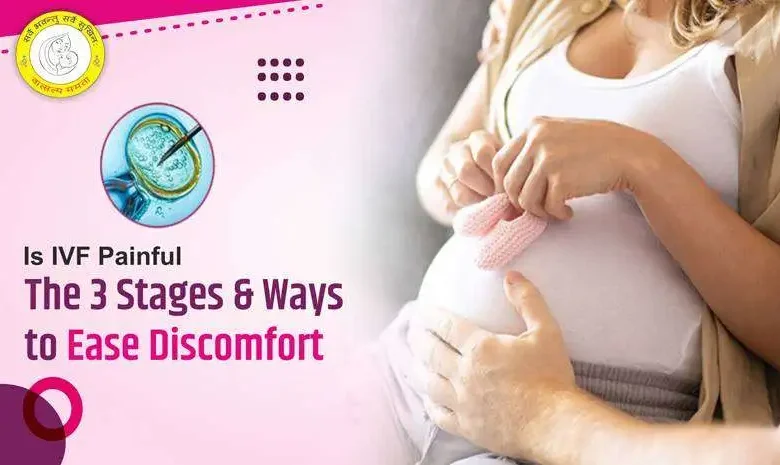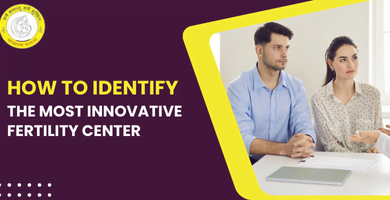Is IVF Painful? 3 Stages and Tips to Ease Discomfort

Nowadays the problem of infertility is increasing among women, due to which they have to take the help of IVF to conceive. Many women who choose the option of IVF do not know whether this process is painful or not.
Many questions arise in the mind of a woman or couple while taking IVF treatment. Many women also have the fear that if they feel pain due to IVF, how will they bear it? Generally, women do not know whether IVF treatment causes pain or not. It is natural for such questions to come to mind and women should get information about it before starting the treatment. This makes them feel safe and comfortable during the treatment.
If your question is also the same, is IVF painful, you are at the right place. Let’s discuss.
Stage 1: Fertility Injections and Stimulation
In this Article
For example, some women find injecting themselves with fertility drugs uncomfortable, not painful. However, self-injection needles are small, and if you are scared, you can have a friend or husband help you do it. Is IVF painful?
Patients are prescribed self-injectable medicines that speed up the process of egg formation in the ovaries during the cycle.
Stage 2: Egg Retrieval Procedure
When your doctor thinks your ovaries have enough mature eggs, they give you another medication to induce ovulation so that the eggs are released. This usually involves giving a hormone called human chorionic gonadotropin (HGC). This causes the eggs to fully mature before ovulation. This trigger shot can cause some side effects like nausea, vomiting, lightheadedness, dizziness and temporary discomfort at the site of injection.
During egg retrieval, the patient is given pain relievers and sedatives so that she does not feel any pain or discomfort during the entire procedure. However, there may be some mild side effects such as cramps, bloating, feeling of pressure and sometimes spotting. Any such discomfort can be treated with medicines such as paracetamol. These symptoms subside within 5 to 7 days.
After retrieval, the woman usually recovers quickly, and you can resume your normal routine after resting for a day or two.
Stage 3: Embryo Transfer
After egg retrieval, it is fertilized in the lab. After this, embryos are selected for transfer to the uterus. These embryos are inserted directly into the uterus using a syringe through a vaginal catheter. At this time, only slight pressure is felt due to the catheter. According to some women, this pressure is like the speculum used in the Pap test. Some women feel a little pain in this process, but most women do not have any problem. After this, the woman becomes normal quickly.
Coping with IVF Failure and Emotional Well-Being
It is very rare for the IVF process to fail. During this time you should be hopeful but also keep in mind that there is a possibility of failure. Usually it takes at least three rounds to make IVF successful when your own eggs are used.
It is natural to feel sad when IVF fails. But do not let this stress overwhelm you, understand that you are not alone, there are many women like you. Many couples suffer from stress, anxiety and depression due to this. It is a bit difficult to keep hope after IVF fails.
Therefore, take advice from a therapist and fertility counselor, so that negativity does not arise in your mind and you can overcome this situation.
Conclusion
So, Is IVF Painful? You have got your answer. While some mild discomfort may be associated with specific stages of the IVF process, the potential for pain is generally low. Patients can work with their healthcare providers to develop a plan to manage discomfort and ensure a smooth and successful IVF experience. For further help or to seek specialist assistance, visit the best IVF treatment centre in Patna.
FAQs
IVF procedure painful
The egg retrieval procedure is performed under sedation, so you won’t feel pain during the process. However, you might experience mild discomfort afterward.
How to sleep during ivf stimulation
Sleeping on your side with a pillow supporting your belly can help alleviate discomfort caused by ovarian enlargement.
Avoid sleeping on your stomach as it can put pressure on your abdomen.
Trigger shot ivf painful
While the trigger shot might cause a brief stint at the injection site, it’s generally well-tolerated.
Applying a warm compress to the area can help soothe any discomfort.
Ovary pain during ivf stimulation
Ovary pain or discomfort is a common side effect of IVF stimulation due to ovarian enlargement.
This pain can range from mild to moderate and is often described as a dull ache.
Warm compresses, over-the-counter pain relievers like ibuprofen (after consulting your doctor), and relaxation techniques can help manage the discomfort.
Abdominal pain during ivf stimulation
Abdominal pain is often linked to ovarian enlargement, but it’s important to differentiate it from other potential causes.
If the pain is severe, accompanied by bloating, nausea, vomiting, or sudden, sharp pain, contact your doctor immediately.
Which is more painful iui or ivf
Generally, IUI (Intrauterine Insemination) is less invasive and causes fewer side effects than IVF. However, individual experiences can vary.
IVF involves ovarian stimulation, egg retrieval, and hormone injections, which can lead to more discomfort.
Sleeping position after embryo transfer
Many fertility clinics recommend resting on your back for a few hours after the embryo transfer.
However, recent studies suggest that there’s no evidence to support a specific sleeping position improving implantation rates.
Choose a position that is comfortable for you.
How to help swollen ovaries after ivf
Rest and avoid strenuous activity.
Drink plenty of water to stay hydrated.
Apply warm compresses to your abdomen.
Over-the-counter pain relievers (after consulting your doctor) can help manage discomfort.
Can you take ibuprofen during ivf stimulation
While ibuprofen can help manage mild to moderate pain, it’s essential to consult your doctor before taking any medication during IVF treatment.
Some fertility clinics may have specific guidelines about pain medication use.



